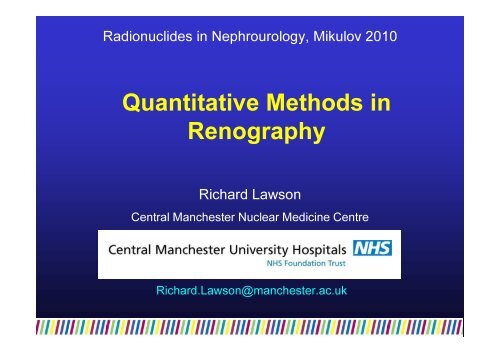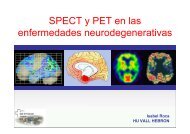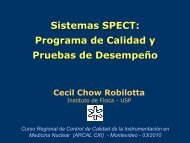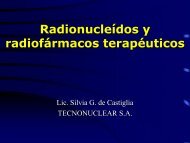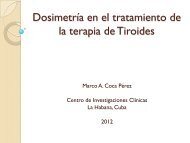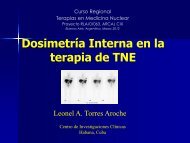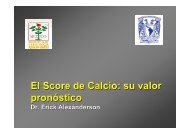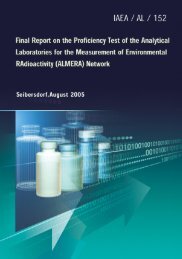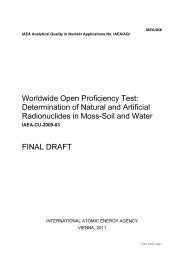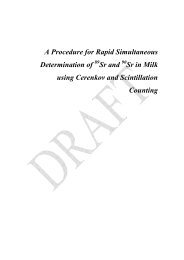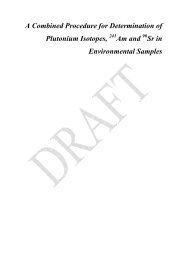Quantitative Methods in Renography - Nucleus
Quantitative Methods in Renography - Nucleus
Quantitative Methods in Renography - Nucleus
You also want an ePaper? Increase the reach of your titles
YUMPU automatically turns print PDFs into web optimized ePapers that Google loves.
Radionuclides <strong>in</strong> Nephrourology, Mikulov 2010<br />
<strong>Quantitative</strong> <strong>Methods</strong> <strong>in</strong><br />
<strong>Renography</strong><br />
Richard Lawson<br />
Central Manchester Nuclear Medic<strong>in</strong>e Centre<br />
Richard.Lawson@manchester.ac.uk
Richard Lawson<br />
Overview<br />
• Problems of quantify<strong>in</strong>g the renogram<br />
• Complex shape of the curve<br />
• Unwanted background<br />
• Background subtraction<br />
• Recognis<strong>in</strong>g correct subtraction<br />
Tissue and vascular background components<br />
• Compare two solutions<br />
• Rutland plot<br />
• Deconvolution<br />
• <strong>Quantitative</strong> parameters<br />
• Relative function<br />
• Absolute function<br />
• Elim<strong>in</strong>ation<br />
ISCORN Consensus Report: Sem.Nucl.Med. 1999, 29:146-159<br />
Central Manchester Nuclear Medic<strong>in</strong>e Centre
<strong>Renography</strong><br />
• <strong>Renography</strong> is a dynamic study of kidney function<br />
• Time is the important dimension<br />
• It is the renogram curves that show transit of tracer<br />
through the kidneys<br />
• So curves are more important than the images<br />
• Upslope of curves demonstrate kidney uptake<br />
• Relative function<br />
one kidney compared with the other<br />
• Absolute function<br />
each kidney compared with normal<br />
• Downslope of curves demonstrate elim<strong>in</strong>ation<br />
It is important to produce the correct curves<br />
Richard Lawson<br />
Central Manchester Nuclear Medic<strong>in</strong>e Centre
The Problems<br />
• The kidney activity-time curve is a comb<strong>in</strong>ation of<br />
three factors:<br />
• Uptake <strong>in</strong>to the kidney<br />
• Transit through the kidney<br />
• Elim<strong>in</strong>ation from the kidney<br />
• Uptake depends on blood activity, which varies with<br />
• Speed of <strong>in</strong>jection<br />
• Kidney function<br />
• Function of the other kidney<br />
• Recirculation of tracer<br />
• Renogram curve is a superimposition of the desired<br />
kidney activity and unwanted background activity<br />
Renogram quantification must overcome these problems<br />
Richard Lawson<br />
Central Manchester Nuclear Medic<strong>in</strong>e Centre
Background Subtraction
Renogram Model<br />
Extravascular<br />
Tissue<br />
Blood<br />
Kidney<br />
Tubules + pelvis<br />
Bladder<br />
Concentration Concentration Concentration Concentration<br />
Time<br />
Time<br />
Time<br />
Richard Lawson<br />
Central Manchester Nuclear Medic<strong>in</strong>e Centre
Renogram Model<br />
Extravascular<br />
Tissue<br />
Concentration<br />
Time<br />
This is the<br />
curve that<br />
we want<br />
Blood<br />
Kidney<br />
Tubules + pelvis<br />
Bladder<br />
Concentration Concentration Concentration<br />
Time<br />
Time<br />
Richard Lawson<br />
Central Manchester Nuclear Medic<strong>in</strong>e Centre
Regions of Interest<br />
Each kidney ROI <strong>in</strong>cludes<br />
• Renal blood vessels<br />
• Renal tubules<br />
• Renal pelvis<br />
• Overly<strong>in</strong>g tissues<br />
Background ROI <strong>in</strong>cludes<br />
• Some blood vessels<br />
• Some tissues<br />
Renogram<br />
Kidney m<strong>in</strong>us background<br />
• Should leave desired renogram<br />
}<br />
Blood background<br />
Tissue background<br />
Blood background<br />
Tissue background<br />
The optimum background ROI must <strong>in</strong>clude the<br />
correct mixture of both blood and tissue background<br />
Richard Lawson<br />
Central Manchester Nuclear Medic<strong>in</strong>e Centre
Background Subtraction<br />
Kidney ROI curve<br />
cps<br />
Richard Lawson<br />
Tissue<br />
+ Renal tubules<br />
& Renal pelvis<br />
+ Blood<br />
Time<br />
Background ROI curve<br />
cps<br />
Tissue<br />
+ Blood<br />
Time<br />
cps<br />
Background subtracted<br />
Renal tubules<br />
& Renal pelvis<br />
Time<br />
If background<br />
subtraction is correct,<br />
renogram curve should<br />
rise smoothly from zero<br />
Central Manchester Nuclear Medic<strong>in</strong>e Centre
Mix<strong>in</strong>g<br />
• Dur<strong>in</strong>g the first few seconds after <strong>in</strong>jection<br />
• Tracer has not had enough time to mix uniformly<br />
throughout all of the blood<br />
Therefore blood activity <strong>in</strong> the background region may<br />
differ from blood activity <strong>in</strong> the kidney region<br />
So background subtraction may be wrong<br />
• Therefore ignore first few seconds of the curve<br />
• Until mix<strong>in</strong>g is complete<br />
Varies between patients<br />
Often about 30 seconds<br />
Possibly up to 1 m<strong>in</strong>ute<br />
Richard Lawson<br />
Central Manchester Nuclear Medic<strong>in</strong>e Centre
Recognis<strong>in</strong>g Correct Subtraction<br />
Curve is not<br />
smooth dur<strong>in</strong>g<br />
first m<strong>in</strong>ute<br />
Extrapolate to<br />
overcome<br />
mix<strong>in</strong>g phase<br />
0 1 2 3 4<br />
5 m<strong>in</strong><br />
Question 1: Is this renogram curve correctly subtracted ?<br />
1 = Correct subtraction, 2 = Under-subtracted, 3 = Over-subtracted<br />
Answer: Under-subtracted<br />
Richard Lawson<br />
Central Manchester Nuclear Medic<strong>in</strong>e Centre
Recognis<strong>in</strong>g Correct Subtraction<br />
0 1 2 3 4<br />
5 m<strong>in</strong><br />
Question 2: Is this renogram curve correctly subtracted ?<br />
1 = Correct subtraction, 2 = Under-subtracted, 3 = Over-subtracted<br />
Answer: Over-subtracted<br />
Richard Lawson<br />
Central Manchester Nuclear Medic<strong>in</strong>e Centre
Recognis<strong>in</strong>g Correct Subtraction<br />
0 1 2 3 4<br />
5 m<strong>in</strong><br />
Question 3: Is this renogram curve correctly subtracted ?<br />
1 = Correct subtraction, 2 = Under-subtracted, 3 = Over-subtracted<br />
Answer: Correct subtraction – after extrapolation<br />
Richard Lawson<br />
Central Manchester Nuclear Medic<strong>in</strong>e Centre
Recognis<strong>in</strong>g Correct Subtraction<br />
If curve has a<br />
k<strong>in</strong>k dur<strong>in</strong>g first<br />
m<strong>in</strong>ute then<br />
extrapolate to<br />
overcome<br />
mix<strong>in</strong>g phase<br />
Under-subtracted<br />
Correctly subtracted<br />
Over-subtracted<br />
0 1 2 3 4<br />
5 m<strong>in</strong><br />
Richard Lawson<br />
Central Manchester Nuclear Medic<strong>in</strong>e Centre
Three Phases of the Renogram<br />
Phase 1<br />
(Vascular)<br />
Phase 2<br />
(Uptake)<br />
Phase 3<br />
(Elim<strong>in</strong>ation)<br />
Textbooks<br />
3 phases<br />
Renogram model<br />
No vascular phase<br />
• Orig<strong>in</strong>ally renograms were acquired us<strong>in</strong>g probes<br />
• Without any means of background subtraction<br />
• The vascular phase was always present<br />
• The vascular phase is not part of the true renogram<br />
• With modern gamma camera techniques it should be<br />
removed by proper computer process<strong>in</strong>g<br />
Richard Lawson<br />
Central Manchester Nuclear Medic<strong>in</strong>e Centre
Teach<strong>in</strong>g Po<strong>in</strong>t<br />
• Background subtraction is correct when the<br />
renogram curve rises smoothly from zero<br />
After extrapolat<strong>in</strong>g to overcome <strong>in</strong>complete mix<strong>in</strong>g<br />
dur<strong>in</strong>g the first m<strong>in</strong>ute<br />
Assum<strong>in</strong>g that the bolus appears <strong>in</strong> kidneys dur<strong>in</strong>g<br />
the first frame of the study – time zero<br />
0 1 m<strong>in</strong><br />
Richard Lawson<br />
Central Manchester Nuclear Medic<strong>in</strong>e Centre
Background Subtraction<br />
Examples
Example 1<br />
• 50 MBq 99m Tc MAG3<br />
• Good uptake <strong>in</strong> both kidneys<br />
• Both kidneys equal function<br />
Richard Lawson<br />
Central Manchester Nuclear Medic<strong>in</strong>e Centre
Example 1 – Background below kidney<br />
Relative function<br />
Left kidney: 50%<br />
Right kidney: 50%<br />
Right Kidney<br />
Left Kidney<br />
Question 4: Are these curves correctly subtracted ?<br />
1 = Correct subtraction, 2 = Under-subtracted, 3 = Over-subtracted<br />
Answer: Slight under-subtraction<br />
Richard Lawson<br />
Central Manchester Nuclear Medic<strong>in</strong>e Centre
Example 1 – Peri-renal background<br />
Relative function<br />
Left kidney: 52%<br />
Right kidney: 48%<br />
Left Kidney<br />
Right Kidney<br />
Question 5: Are these curves correctly subtracted ?<br />
1 = Correct subtraction, 2 = Under-subtracted, 3 = Over-subtracted<br />
Answer: Very slight under-subtraction<br />
Richard Lawson<br />
Central Manchester Nuclear Medic<strong>in</strong>e Centre
Example 1 – Rutland method<br />
L<br />
R<br />
Relative function<br />
Left kidney: 52%<br />
Right kidney: 48%<br />
Question 6: Are these curves correctly subtracted ?<br />
Answer: Correct subtraction<br />
Right Kidney<br />
Left Kidney<br />
1 = Correct subtraction, 2 = Under-subtracted, 3 = Over-subtracted<br />
Richard Lawson<br />
Central Manchester Nuclear Medic<strong>in</strong>e Centre
Teach<strong>in</strong>g Po<strong>in</strong>t<br />
• If us<strong>in</strong>g MAG3 and kidney function is good<br />
Us<strong>in</strong>g different background regions only makes a<br />
small difference to background subtraction<br />
• If both kidneys have equal function<br />
Then under-subtract<strong>in</strong>g doesn’t alter relative<br />
function significantly<br />
Richard Lawson<br />
Central Manchester Nuclear Medic<strong>in</strong>e Centre
Example 2<br />
• 50MBq 99m Tc MAG3<br />
• Both kidneys poor function<br />
• Right worse than left<br />
Richard Lawson<br />
Central Manchester Nuclear Medic<strong>in</strong>e Centre
Example 2 – Background below kidney<br />
L<br />
R<br />
Relative function<br />
Left kidney: 56%<br />
Right kidney: 44%<br />
Right Kidney<br />
Left Kidney<br />
Question 7: Are these curves correctly subtracted ?<br />
1 = Correct subtraction, 2 = Under-subtracted, 3 = Over-subtracted<br />
Answer: Significantly under-subtracted – after extrapolation<br />
Richard Lawson<br />
Central Manchester Nuclear Medic<strong>in</strong>e Centre
Example 2 – Peri-renal background<br />
L<br />
R<br />
Relative function<br />
Left kidney: 90%<br />
Right kidney: 10%<br />
Question 8: Are these curves correctly subtracted ?<br />
Answer: Over-subtracted<br />
Right Kidney<br />
Left Kidney<br />
1 = Correct subtraction, 2 = Under-subtracted, 3 = Over-subtracted<br />
Richard Lawson<br />
Central Manchester Nuclear Medic<strong>in</strong>e Centre
Example 2 – Rutland method<br />
L<br />
R<br />
Relative function<br />
Left kidney: 66%<br />
Right kidney: 34%<br />
Right Kidney<br />
Left Kidney<br />
Question 9: Are these curves correctly subtracted ?<br />
1 = Correct subtraction, 2 = Under-subtracted, 3 = Over-subtracted<br />
Answer: Correct subtraction – after extrapolation<br />
Richard Lawson<br />
Central Manchester Nuclear Medic<strong>in</strong>e Centre
Teach<strong>in</strong>g Po<strong>in</strong>t<br />
• If us<strong>in</strong>g MAG3 and function is poor<br />
• Then different background regions can have a<br />
big effect<br />
• If us<strong>in</strong>g DTPA this happens even with good<br />
function<br />
• Because of lower extraction efficiency<br />
• If function is asymmetric<br />
Then <strong>in</strong>correct background subtraction can<br />
affect relative function measurement<br />
Richard Lawson<br />
Central Manchester Nuclear Medic<strong>in</strong>e Centre
Example 3<br />
• 50 MBq 99m Tc MAG3<br />
• Left kidney good function<br />
• Right kidney hydronephrotic<br />
Richard Lawson<br />
Central Manchester Nuclear Medic<strong>in</strong>e Centre
Example 3 - Background below kidney<br />
L<br />
R<br />
Right Kidney<br />
Relative function<br />
Left kidney: 76%<br />
Right kidney: 24%<br />
Left Kidney<br />
Question 10: Is the right kidney curve correctly subtracted ?<br />
1 = Correct subtraction, 2 = Under-subtracted, 3 = Over-subtracted<br />
Answer: Under-subtracted<br />
Richard Lawson<br />
Left kidney little under-subtracted<br />
Central Manchester Nuclear Medic<strong>in</strong>e Centre
Example 3 – Peri-renal background<br />
L<br />
R<br />
Right Kidney<br />
Relative function<br />
Left kidney: 85%<br />
Right kidney: 15%<br />
Left Kidney<br />
Question 11: Is the right kidney curve correctly subtracted ?<br />
1 = Correct subtraction, 2 = Under-subtracted, 3 = Over-subtracted<br />
Answer: Over-subtracted But left kidney is OK<br />
Richard Lawson<br />
Central Manchester Nuclear Medic<strong>in</strong>e Centre
Example 3 – Rutland method<br />
L<br />
R<br />
Right Kidney<br />
Relative function<br />
Left kidney: 81%<br />
Right kidney: 19%<br />
Left Kidney<br />
Question 12: Is the right kidney curve correctly subtracted ?<br />
1 = Correct subtraction, 2 = Under-subtracted, 3 = Over-subtracted<br />
Answer: Correct subtraction<br />
Richard Lawson<br />
For both kidneys<br />
Central Manchester Nuclear Medic<strong>in</strong>e Centre
Teach<strong>in</strong>g Po<strong>in</strong>t<br />
• If the vascularity of each kidney is different<br />
Then it is difficult to f<strong>in</strong>d a s<strong>in</strong>gle background<br />
region that works for both kidneys<br />
• The Rutland method overcomes this by<br />
automatically adjust<strong>in</strong>g the amount of vascular<br />
background to suit each kidney<br />
Richard Lawson<br />
Central Manchester Nuclear Medic<strong>in</strong>e Centre
The Rutland Method
The Rutland Method *<br />
• The real renogram is the response of the kidney<br />
to a s<strong>in</strong>gle <strong>in</strong>jection<br />
• Result<strong>in</strong>g <strong>in</strong> a blood activity that is cont<strong>in</strong>ually<br />
fall<strong>in</strong>g<br />
• Imag<strong>in</strong>e what the renogram would look like if we<br />
gave a constant <strong>in</strong>fusion<br />
• The blood activity could be kept constant<br />
• The Rutland method predicts what the constant<br />
<strong>in</strong>fusion renogram would look like<br />
• Based on the real renogram<br />
• And the real blood curve<br />
* Rutland MD Nuc.Med.Comm 6: p11-20 (1985)<br />
Richard Lawson<br />
Central Manchester Nuclear Medic<strong>in</strong>e Centre
Constant Infusion Model<br />
Extravascular<br />
Tissue<br />
Blood<br />
Kidney<br />
Bladder<br />
Concentration Concentration Concentration Concentration<br />
Time<br />
Time<br />
Time<br />
Richard Lawson<br />
Central Manchester Nuclear Medic<strong>in</strong>e Centre
Def<strong>in</strong>e:<br />
Blood activity<br />
Kidney activity<br />
Assumptions:<br />
Now:<br />
Richard Lawson<br />
Rutland Theory<br />
B = Vascular ROI counts<br />
K = True kidney counts + Vascular background<br />
⎛<br />
⎜<br />
⎝<br />
K = Kidney ROI counts<br />
1) Input rate to kidney is proportional to B<br />
2) Noth<strong>in</strong>g leaves dur<strong>in</strong>g first few m<strong>in</strong>utes<br />
3) Vascular background = a x B (where a is a background subtraction factor)<br />
K<br />
K<br />
B<br />
⎞<br />
⎟<br />
⎠<br />
= UC × ∫ Bdt + a×<br />
B<br />
⎛ Bdt ⎞<br />
UC ⎜∫<br />
= × ⎟ + a<br />
⎜ B ⎟<br />
⎝ ⎠<br />
Tissue ROI counts<br />
(scaled for ROI size)<br />
True kidney counts = UC x ∫Bdt<br />
(where UC is an uptake constant)<br />
‘Rutland time’<br />
This is the equation of a straight l<strong>in</strong>e with slope ‘UC’ and <strong>in</strong>tercept ‘a’<br />
-<br />
-<br />
Tissue ROI counts<br />
(scaled for ROI size)<br />
Rutland Plot<br />
(Patlak plot)<br />
Central Manchester Nuclear Medic<strong>in</strong>e Centre
Rutland Practice<br />
• Draw regions of <strong>in</strong>terest<br />
L<br />
• Kidneys<br />
• Vascular background<br />
heart or spleen<br />
• Tissue background<br />
below kidney<br />
• Bladder<br />
• Generate activity-time curves<br />
• Subtract tissue background<br />
• from kidneys, bladder and vascular<br />
(scal<strong>in</strong>g only for region size)<br />
• Construct Rutland plot for each kidney<br />
• Select range of po<strong>in</strong>ts to fit straight l<strong>in</strong>e<br />
R<br />
Post<br />
Richard Lawson<br />
Central Manchester Nuclear Medic<strong>in</strong>e Centre
Choos<strong>in</strong>g the fit range<br />
*<br />
Fit should <strong>in</strong>clude<br />
just po<strong>in</strong>ts <strong>in</strong><br />
straight section<br />
*<br />
* * * *<br />
Typical Rutland Plot<br />
Late po<strong>in</strong>ts will be below the l<strong>in</strong>e<br />
(kidney is empty<strong>in</strong>g)<br />
Early po<strong>in</strong>ts may be below the l<strong>in</strong>e<br />
(<strong>in</strong>complete mix<strong>in</strong>g)<br />
Richard Lawson<br />
Central Manchester Nuclear Medic<strong>in</strong>e Centre
Rutland Practice (cont<strong>in</strong>ued)<br />
• Calculate relative function<br />
• Us<strong>in</strong>g ratio of slopes from Rutland fit<br />
• Subtract vascular background<br />
• Us<strong>in</strong>g factor from Rutland fit <strong>in</strong>tercept<br />
• Display background subtracted curves as usual<br />
• Guarantees that curves start at zero<br />
Relative function<br />
Left kidney: 81%<br />
Right kidney: 19%<br />
Richard Lawson<br />
Central Manchester Nuclear Medic<strong>in</strong>e Centre
Summary - Rutland<br />
The Rutland plot is a mathematical manipulation<br />
of the renogram that simulates what would<br />
happen if blood activity was constant<br />
Kidney Counts / Blood Counts<br />
U ptake<br />
Blood background<br />
Rutland Plot<br />
Slope is a<br />
measure of the<br />
kidney function<br />
Rutland Time<br />
Intercept tells us<br />
how much blood<br />
background to<br />
subtract<br />
Richard Lawson<br />
Central Manchester Nuclear Medic<strong>in</strong>e Centre
Deconvolution
Simple Kidney Model<br />
Renal<br />
Artery<br />
Renal<br />
Ve<strong>in</strong><br />
Blood Activity<br />
Bolus Input<br />
Renal<br />
Tubules<br />
Glomerulus<br />
Kidney Activity<br />
Transit<br />
time<br />
Elim<strong>in</strong>ation<br />
Renal<br />
Pelvis<br />
Uptake<br />
Impulse<br />
Retention<br />
Function<br />
Richard Lawson<br />
Ureter<br />
time<br />
Central Manchester Nuclear Medic<strong>in</strong>e Centre
Mean Transit Time<br />
Impulse Retention Function<br />
MTT<br />
Mean transit time is<br />
the average time for<br />
a molecule to pass<br />
through the system<br />
Initial Height<br />
H(t)<br />
Two areas are equal<br />
Area<br />
MTT =<br />
Initial height<br />
Richard Lawson<br />
time<br />
Central Manchester Nuclear Medic<strong>in</strong>e Centre
‘Idealised’ Renogram<br />
Blood Activity<br />
• Perfect bolus Input<br />
• But not practicable<br />
• Perfect <strong>in</strong>jection<br />
• Direct <strong>in</strong>to renal artery<br />
• No recirculation<br />
time<br />
• Impulse Response<br />
• But easy to <strong>in</strong>terpret<br />
• Uptake, transit and<br />
elim<strong>in</strong>ation are separated<br />
Uptake<br />
Kidney Activity<br />
Transit<br />
Elim<strong>in</strong>ation<br />
Richard Lawson<br />
time<br />
Central Manchester Nuclear Medic<strong>in</strong>e Centre
But what about the real renogram ?<br />
Blood Activity<br />
• IV <strong>in</strong>jection<br />
• Slow recirculation<br />
• Blood activity persists<br />
time<br />
Kidney Activity<br />
• Real Renogram<br />
• What shape is the<br />
kidney curve ? ?<br />
Richard Lawson<br />
time<br />
Central Manchester Nuclear Medic<strong>in</strong>e Centre
Convolution<br />
100<br />
Must be l<strong>in</strong>ear<br />
Must be stationary<br />
50%<br />
50%<br />
70 35<br />
25<br />
50<br />
50%<br />
50<br />
Richard Lawson<br />
Input<br />
time<br />
Represent blood curve as<br />
series of bolus <strong>in</strong>puts<br />
Response<br />
time<br />
Central Manchester Nuclear Medic<strong>in</strong>e Centre
Deconvolution<br />
100<br />
70<br />
50<br />
100<br />
50<br />
100<br />
50<br />
100<br />
50%<br />
40<br />
100<br />
25<br />
18<br />
50<br />
36<br />
24<br />
40%<br />
35<br />
35<br />
25<br />
35<br />
12<br />
18<br />
25<br />
12<br />
18<br />
Input<br />
time<br />
50<br />
50<br />
50<br />
40<br />
28<br />
20<br />
12<br />
14<br />
Richard Lawson<br />
Response<br />
time<br />
Central Manchester Nuclear Medic<strong>in</strong>e Centre
Convolution<br />
Bolus<br />
R 4<br />
R 3<br />
I(t)<br />
R 2<br />
I 1<br />
I 2 R 1<br />
I 3<br />
I 4<br />
R(t)<br />
Input<br />
time<br />
H(t)<br />
H 1 H 2 H 3 H 4<br />
Richard Lawson<br />
Response<br />
time<br />
Central Manchester Nuclear Medic<strong>in</strong>e Centre
Deconvolution<br />
Bolus<br />
R 4<br />
R 3<br />
I(t)<br />
R 2<br />
I 1<br />
I 2 R 1<br />
I 3<br />
I 4<br />
R(t)<br />
Input<br />
time<br />
H(t)<br />
H 1 H 2 H 3 H 4<br />
Richard Lawson<br />
Response<br />
time<br />
Central Manchester Nuclear Medic<strong>in</strong>e Centre
Teach<strong>in</strong>g Po<strong>in</strong>t<br />
• Given the <strong>in</strong>put to a system I(t) and the response<br />
to that <strong>in</strong>put R(t), you can use deconvolution to<br />
calculate the expected response to an ideal<br />
impulse <strong>in</strong>put<br />
• This is the impulse retention function , H(t)<br />
• The impulse retention function is easy to <strong>in</strong>terpret<br />
because<br />
• The <strong>in</strong>itial height represents uptake<br />
• The duration represents transit<br />
• The downslope represents elim<strong>in</strong>ation<br />
Richard Lawson<br />
Central Manchester Nuclear Medic<strong>in</strong>e Centre
How to do it<br />
R ( t)<br />
= I(<br />
t) * H ( t)<br />
R<br />
i<br />
=<br />
i<br />
∑<br />
j=<br />
1<br />
I<br />
j<br />
⋅<br />
H<br />
i−j+<br />
1∆<br />
t<br />
• Matrix method<br />
• As previous illustration<br />
• Fourier transform<br />
• FT of a convolution is<br />
product of FTs<br />
H<br />
i<br />
⎡<br />
i<br />
1 R<br />
− i<br />
= ⎢ −∑ I1<br />
⎣∆t<br />
j=<br />
⎛<br />
H ( t)<br />
= F<br />
-1<br />
⎜<br />
⎝<br />
• Constra<strong>in</strong>ed optimisation<br />
• F<strong>in</strong>d smooth solution consistent with noise<br />
F<br />
1<br />
1<br />
I<br />
i−j+<br />
1<br />
{ R(<br />
t)<br />
}<br />
F<br />
⋅ H<br />
j<br />
⎥<br />
⎦<br />
⎤<br />
⎞<br />
{ I(<br />
t)<br />
} ⎟ ⎠<br />
1. ISCORN Consensus report. Durand E, et al Sem<strong>in</strong>.Nucl.Med. 2008, 38:82-102<br />
2. “Application of mathematical methods <strong>in</strong> dynamic nuclear medic<strong>in</strong>e studies”<br />
Lawson RS. Phys. Med. Biol. 1999, 44: R57-98<br />
Richard Lawson<br />
Central Manchester Nuclear Medic<strong>in</strong>e Centre
Renogram Deconvolution<br />
Blood Activity<br />
Deconvolution<br />
Renogram<br />
Richard Lawson<br />
Bolus Input<br />
Impulse Response Function<br />
Central Manchester Nuclear Medic<strong>in</strong>e Centre
Effect of Vascular Background<br />
Before Deconvolution<br />
Kidney Activity<br />
=<br />
Blood Activity<br />
+<br />
Renogram<br />
Richard Lawson<br />
Vascular Background<br />
Not easy to<br />
remove<br />
background<br />
Central Manchester Nuclear Medic<strong>in</strong>e Centre
Effect of Vascular Background<br />
After Deconvolution<br />
Kidney Activity<br />
=<br />
Blood Activity<br />
+<br />
Renogram<br />
Vascular Background<br />
Easy to<br />
remove<br />
background<br />
Richard Lawson<br />
Central Manchester Nuclear Medic<strong>in</strong>e Centre
Renogram Example - Raw Curves<br />
Activity-time curves<br />
After smooth<strong>in</strong>g<br />
Richard Lawson<br />
Central Manchester Nuclear Medic<strong>in</strong>e Centre
After Deconvolution<br />
Impulse Response Functions<br />
Relative<br />
Function<br />
MTT<br />
LEFT 41% 10.5 m<strong>in</strong><br />
RIGHT 59% 4.9 m<strong>in</strong><br />
After trimm<strong>in</strong>g<br />
RIGHT KIDNEY<br />
LEFT KIDNEY<br />
Richard Lawson<br />
Central Manchester Nuclear Medic<strong>in</strong>e Centre
Practical Considerations<br />
• System must be l<strong>in</strong>ear<br />
• OK<br />
• System must be stationary<br />
• No furosemide<br />
• No large pelvic contractions<br />
• Suitable ROI for blood <strong>in</strong>put<br />
• Aorta or heart<br />
With tissue background subtracted<br />
• Suitable ROI for kidney contents<br />
• Whole kidney<br />
• Renal parenchyma (whole kidney - pelvis)<br />
With tissue background subtracted<br />
Richard Lawson<br />
Central Manchester Nuclear Medic<strong>in</strong>e Centre
More Practical Considerations<br />
• Correct start time<br />
• Problems if kidney activity appears later than heart<br />
• Need good statistics<br />
• Use higher adm<strong>in</strong>istered activity<br />
• Must smooth curves<br />
But not too much<br />
• Identify plateau of retention function<br />
• Difficult if curves are too noisy<br />
• Height is used to measure relative function<br />
• Extrapolate to remove vascular background<br />
• Produce background subtracted renogram<br />
• By reconvolv<strong>in</strong>g subtracted retention function with<br />
blood <strong>in</strong>put curve<br />
Richard Lawson<br />
Central Manchester Nuclear Medic<strong>in</strong>e Centre
Summary - Deconvolution<br />
Deconvolution gives the renogram that would be<br />
obta<strong>in</strong>ed if an idealised bolus <strong>in</strong>jection<br />
could be given straight <strong>in</strong>to the renal artery<br />
with no recirculation<br />
Impulse<br />
Retention<br />
Function<br />
Uptake<br />
transit<br />
Vascular<br />
Background<br />
Mean Transit Time<br />
Elim<strong>in</strong>at ion<br />
Richard Lawson<br />
Time<br />
Central Manchester Nuclear Medic<strong>in</strong>e Centre
<strong>Quantitative</strong> Parameters
Renogram Components<br />
Uptake<br />
Elim<strong>in</strong>ation<br />
Activity<br />
Elim<strong>in</strong>ation<br />
starts<br />
Uptake<br />
only<br />
Transit<br />
Renogram peaks when<br />
rate of uptake = rate of elim<strong>in</strong>ation<br />
Difference<br />
= kidney<br />
contents<br />
Downslope when<br />
rate of elim<strong>in</strong>ation is<br />
greater than rate of uptake<br />
Renogram<br />
Richard Lawson<br />
Time<br />
Central Manchester Nuclear Medic<strong>in</strong>e Centre
Richard Lawson<br />
Quantify<strong>in</strong>g Relative Function<br />
Dur<strong>in</strong>g first 2 or 3 m<strong>in</strong>utes there is no elim<strong>in</strong>ation<br />
• So we can calculate relative uptake from:<br />
• Relative counts <strong>in</strong> summed image<br />
• eg 1 to 3 m<strong>in</strong><br />
Difficult to get correct background subtraction<br />
• Relative area under uptake phase of curves<br />
• eg from 1 to 3 m<strong>in</strong><br />
Provided background subtraction is correct<br />
• Relative height of impulse retention function<br />
• After deconvolution<br />
Provided plateau can be identified<br />
• Relative slope of Rutland plot<br />
• Us<strong>in</strong>g l<strong>in</strong>ear fit<br />
Guarantees correct background subtraction<br />
Central Manchester Nuclear Medic<strong>in</strong>e Centre
Quantify<strong>in</strong>g Absolute Function<br />
• Absolute function is much harder than relative<br />
function<br />
• Compare kidney activity with adm<strong>in</strong>istered activity<br />
• Us<strong>in</strong>g known camera sensitivity<br />
eg Manchester method<br />
• By imag<strong>in</strong>g dose syr<strong>in</strong>ge first<br />
eg Gates method<br />
(Gates GF. Am.J.Roentgenol,1982, 138: 565-70)<br />
• Compare kidney activity with blood curve<br />
• Calibrate by tak<strong>in</strong>g one blood sample<br />
(eg Piepsz A et.al. Eur.J.Nucl.Med. 1977, 2:173-77)<br />
• Proper measurement requires formal blood clearance<br />
• Multiple blood samples<br />
(ISCORN Report. Blaufox et.al. J.Nucl.Med 1997, 37: 1883-1890)<br />
Richard Lawson<br />
Central Manchester Nuclear Medic<strong>in</strong>e Centre
Quantify<strong>in</strong>g Elim<strong>in</strong>ation<br />
Integrate blood <strong>in</strong>put and fit to uptake phase (Rutland plot)<br />
Extrapolate to later times = Zero output curve<br />
Activity<br />
Uptake phase<br />
Difference between<br />
zero output and<br />
Renogram<br />
= Ur<strong>in</strong>e output<br />
Ur<strong>in</strong>e Output / Zero Output<br />
= Renal Output Efficiency *<br />
Renogram<br />
Blood (<strong>in</strong>put)<br />
* Chaiwatanarat et. al. J.Nucl.Med. 1993, 34: 845-848<br />
Time<br />
Richard Lawson<br />
Central Manchester Nuclear Medic<strong>in</strong>e Centre
We have looked at two <strong>Methods</strong><br />
• The problem<br />
• Variable <strong>in</strong>put function<br />
Complex curve shape & superimposed background<br />
• The solution<br />
• Standardise <strong>in</strong>put function<br />
Simpler curve shape with separable background<br />
• Delta function <strong>in</strong>put<br />
• Perfect bolus <strong>in</strong>jection<br />
Impossible <strong>in</strong> practice<br />
Bolus spread<strong>in</strong>g and recirculation<br />
Calculate us<strong>in</strong>g:<br />
Deconvolution<br />
• Constant <strong>in</strong>put<br />
• Cont<strong>in</strong>uous <strong>in</strong>fusion<br />
Possible but complicated<br />
Rutland plot<br />
Richard Lawson<br />
Central Manchester Nuclear Medic<strong>in</strong>e Centre
Comparison of <strong>Methods</strong><br />
Renogram<br />
Deconvolution<br />
• Quantifies uptake<br />
• Quantifies MTT<br />
• Facilitates vascular<br />
background removal<br />
• Very sensitive to noise<br />
• Sensitive to tim<strong>in</strong>g<br />
errors<br />
• Spoiled by furosemide<br />
Rutland Plot<br />
• Quantifies uptake<br />
• ?<br />
• Facilitates vascular<br />
background removal<br />
• Insensitive to noise<br />
• Robust aga<strong>in</strong>st tim<strong>in</strong>g<br />
errors<br />
• Still OK with furosemide<br />
Richard Lawson<br />
Central Manchester Nuclear Medic<strong>in</strong>e Centre
Summary<br />
Real<br />
renogram<br />
Blood Activity<br />
Kidney<br />
Background<br />
Renogram<br />
Deconvolution<br />
Bolus <strong>in</strong>put<br />
Background<br />
Kidney<br />
MTT<br />
Impulse<br />
Retention<br />
Function<br />
Rutland plot<br />
Integrate<br />
Rutland<br />
Constant <strong>in</strong>fusion<br />
Kidney<br />
MTT<br />
Background<br />
Richard Lawson<br />
Central Manchester Nuclear Medic<strong>in</strong>e Centre
Richard Lawson<br />
ISCORN Reports<br />
Quantification of the renogram<br />
Prigent A, Cosgriff PS, Gates GF, et al.<br />
Consensus report on quality control of quantitative measurements of<br />
renal function obta<strong>in</strong>ed from the renogram.<br />
Sem<strong>in</strong>.Nucl.Med. 1999 29:146-159.<br />
Renal transit times<br />
Durand E, Blaufox MD, Britton KE, et al<br />
ISCORN Consensus on renal transit time measurements.<br />
Sem<strong>in</strong>.Nucl.Med. 2008, 38:82-102<br />
Renal clearance<br />
Blaufox MD, Aurell M, Bubeck B et al.<br />
Report of the Radionuclides <strong>in</strong> Nephrourology Committee on renal<br />
clearance.<br />
J Nucl Med 1997; 37:1883-1890.<br />
Central Manchester Nuclear Medic<strong>in</strong>e Centre


